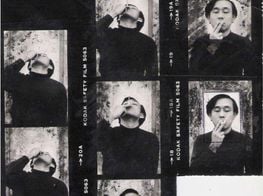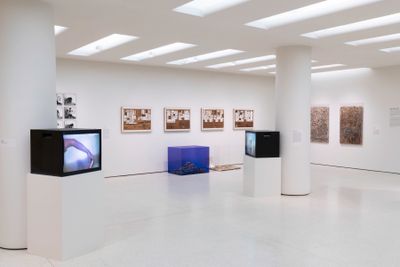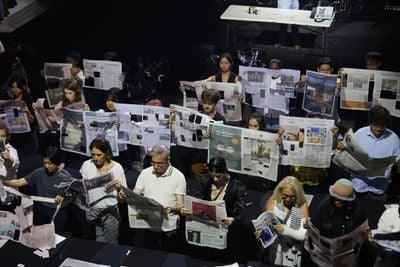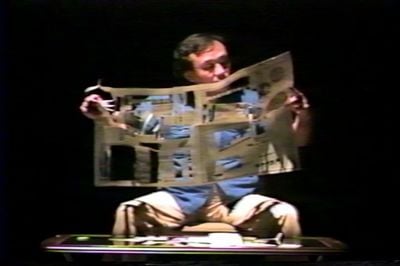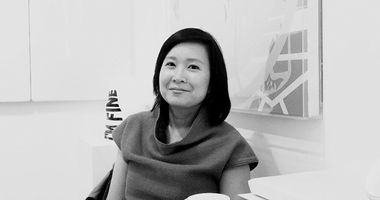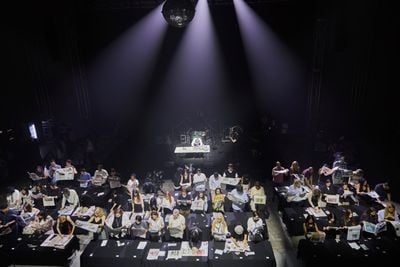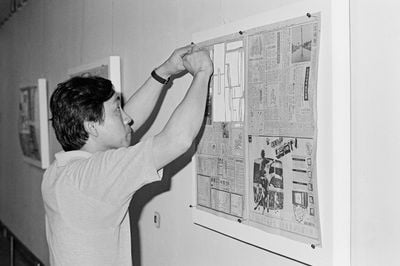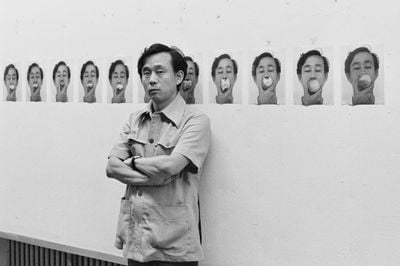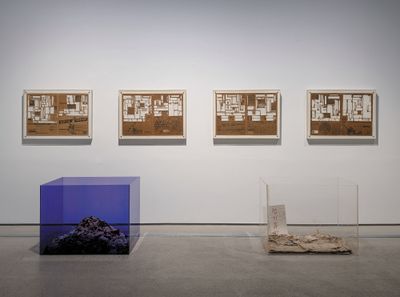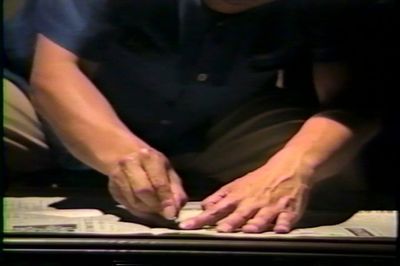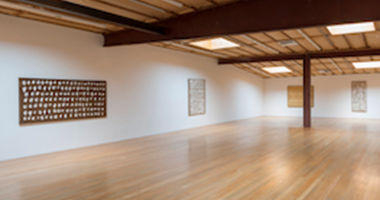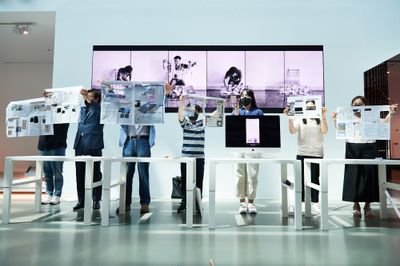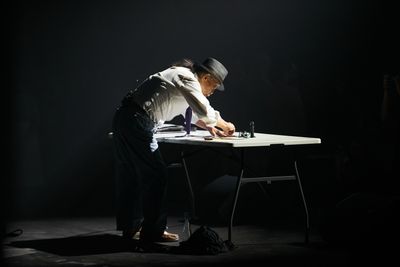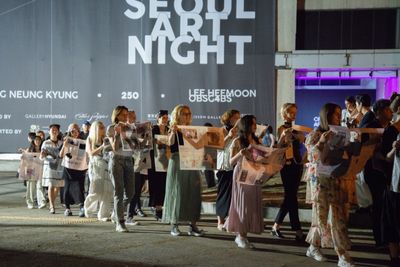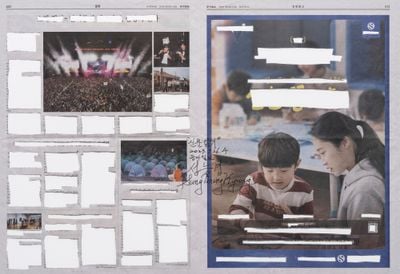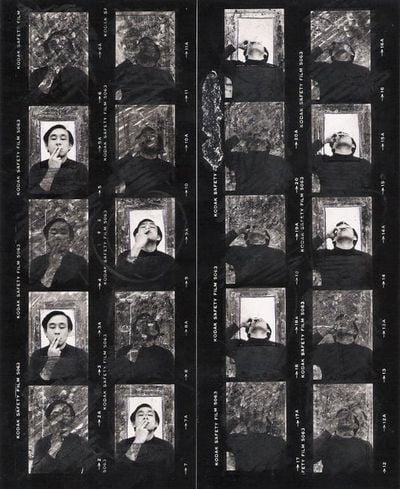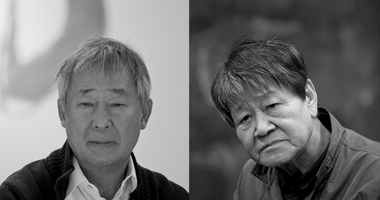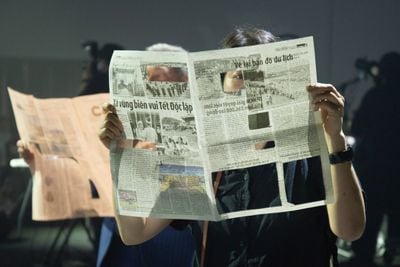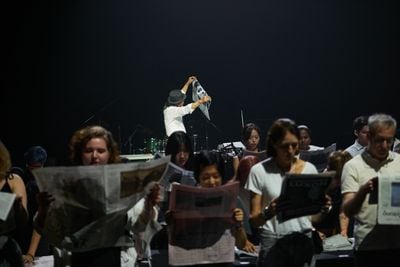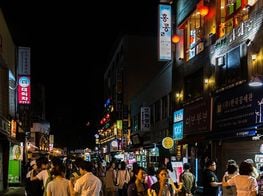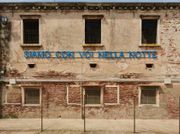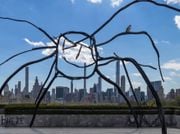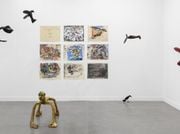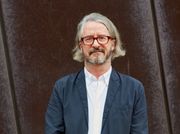Sung Neung Kyung on Reading Newspapers and Botched Art
Performance view: Sung Neung Kyung, Reading Newspapers, Seoul Art Night (6 September 2023). Organised by Gallery Hyundai, Seoul. Courtesy the artist and Gallery Hyundai. Photo: studio idea & jw studio.

Performance view: Sung Neung Kyung, Reading Newspapers, Seoul Art Night (6 September 2023). Organised by Gallery Hyundai, Seoul. Courtesy the artist and Gallery Hyundai. Photo: studio idea & jw studio.
Almost 80, Sung Neung Kyung is receiving global art world attention for his radical practice, having spent decades using photography, installation, and performance to create what he refers to as 'botched art'.
Sung features prominently in the Solomon R. Guggenheim Museum's exhibition Only the Young: Experimental Art in Korea, 1960s–1970s (1 September 2023–7 January 2024), which examines the work of a group of artists who came of age in the wake of the Korean War. It is the first North American museum show dedicated to what art historian Gim Mi-gyeong termed in the early 2000s as 'Korean Experimental art' (silheom misul), and what the curators have defined as relevant to 'some of the most significant avant-garde practices of the twentieth century'.
As part of the Guggenheim's public programme, on 17 and 18 November 2023, Sung will perform Reading Newspapers (1976) in New York. This performance follows an ambitious iteration of the work presented in Seoul this past September involving over 100 people.
With the support of Gallery Hyundai, the artist had sought 100 non-Korean participants for a performance of Reading Newspapers, asking each participant to bring a paper, ideally from their home country. While some of those participating in Sung's performance were in Seoul for the art fairs Frieze and Kiaf, many were international students who had responded to a callout to Korea University and Sungkyunkwan University. As a participant, I hung somewhere in the age balance between the 20-something students and the artist, easily recognisable with his long ponytail and goatee.
Performed on 6 September 2023—the inaugural Seoul Art Night—in a warehouse-like space in Godeok-dong, the work began in darkness, with participants standing in silent, straight lines to face the audience and the artist positioned on a raised stage towards the back of the group. At the direction of Sung, different sections of the assembly were lit up one after the other. The light was a cue, at which participants began to read aloud an article from their newspaper before cutting it out and then repeating the action. The result was that a soft murmuring of voices gradually rose to a chorus of overlapping sentences and fragmented words until, with the entire assembly bathed in light, the space was filled with a thunderous wall of incomprehensible sound.
Just as abruptly as it had begun, the performance ended; at the direction of Sung, the room was plunged suddenly back into darkness, and the group fell silent. The participants then followed the artist in single file out of the space to another building, where Sung photographed each participant holding their cut-out newspaper. Characteristic of Sung's process, the one-off performance event will be archived as photographs or contact prints to be installed in various configurations.
To be situated within the symphony of voices brought together for Sung's performance was something quite extraordinary. Writing for Artforum, art historian Joan Kee described Sung's early works as outlining 'a realm that distinguished communication from content creation, urging viewers to ask how things mean'. In the execution of this most recent work, each participant's experience of the performance was mediated not only by the artist but by what was read aloud by their immediate neighbours and their tuning in and out to specific words within a chorus of many.
Reading Newspapers continues a performance series first begun in 1974 with Newspaper: From June 1, 1974, On (1974). By this time, Sung had completed his studies at Hongik University and his compulsory military service and was working with a loose association of artists who referred to themselves under the name Space and Time (ST). The group included artists such as Lee Kun-Yong, who invited Sung to join in 1973, and who, like Sung, was responding to both Western art and theory and the political turmoil in South Korea.
The Newspaper work saw the artist use a razor to remove blocks of text from Dong-a Ilbo—a daily paper then known for its critical stance toward the South Korean government—for two months in 1974. It culminated in a week-long performance for The 3rd ST Exhibition at the National Museum of Modern and Contemporary Art in Deoksugung Palace in Seoul. In the exhibition, Sung displayed four sheets of the newspaper with blank spaces on the gallery wall, while on the ground, papers that were previously displayed were discarded in a colourless transparent container, and the cut-out pieces of text were stored in a neighbouring tinted-blue container. For the week-long duration of the exhibition, he performed both the cutting and posting of newspapers in the exhibition space.
Sung describes Reading Newspapers, and the works of many of his ST counterparts as emerging from the context of South Korea under Park Chung-hee's regime, when the lives of ordinary citizens were marked by a tightly controlled state elite and the suppression of civil rights. He notes that both official and self-censorship prevailed during this time, with editors of daily newspapers navigating restrictions on free speech to mediate the dissemination of information and ideas, and artists needing to tread carefully to avoid arrest or detention for work that fell afoul of government rules, and social norms.
In this interview, Sung discusses Reading Newspapers, touching on the political and social context from which the work emerged and elaborating on different aspects of his practice, including what he means by 'botched art'.
ADYou went to art school in 1963. Why did you become an artist?
SNKMy elder cousin Sung Chan Kyeong, who later made a name for himself as a poet, came back to Yesan less than a year into his freshman year at the department of English Language and Literature at Seoul National University. There were two factors that contributed to his move back to the countryside: tuberculosis and the imminent Korean War.
In addition to poetry, Sung Chan Kyeong was erudite in other genres of art such as visual art and music since his high school years. It was through him that I encountered visual art. When I was seven years old, he remarked, 'I think you should do art. Make art.' [His words] served as a turning point. I blindly followed his words, and never doubted him once.
Sung Chan Kyeong introduced music into my life. We would listen to classical music such as Mozart's 'Symphony No. 40 & 41' and Schumann's song cycles and choral works such as 'Zigeunerleben', which translates to 'Gypsy Life'—perhaps this contributes to my commitment to 'meanderings'?—with gramophone SP records.
There were also other instances pertaining to music. On the day of the first full moon of the lunar calendar every year, our village was filled with the sound of gongs from traditional Korean music from communal rites and rustic entertainment (called Nongak). There were also puppet shows and performances by one-man gypsy bands on market days. Ritual prayers were recited during ancestral rites. Such sounds and experiences—from both the East and West—came to constitute the bedrock of my art, having become ingrained in the depths of my consciousness.
ADIn 1973, you joined the Space & Time group. What do you think drew you together more than anything else?
SNKI don't think ST really 'drew us together'. Rather, it was a group that was formed loosely as a collective of interpersonal relationships. The one common denominator we all shared was 'art'. ST consisted mostly of artists who graduated from Seoul National University or Hongik University.
I began my compulsory military service in 1970 and was discharged early in the spring of 1973. I joined ST shortly thereafter, upon fellow artist Lee Kun-Yong's recommendation, which led to my participation in The 2nd ST Exhibition in 1973. I remained an active participant until the group was dissolved. Other than artmaking, the members read essays and manifestos such as Joseph Kosuth's [1969 essay] 'Art after Philosophy, which was translated into Korean by Chang Hwa-Jin, a fellow artist who was later appointed professor at Ewha Womans University, as a group.
ADYou started working with newspapers in 1974. Your first piece was Newspaper: From June 1, 1974, On (1974), a work you presented at The 3rd ST Exhibition. Tell me about how that work was received when you did it.
SNKIt was quiet.
The work was not something that could become the subject of heated discussions. Taking into consideration the socio-political milieu of the 1970s, everyone kept their mouths shut.
One day, as I was in the exhibition hall cutting up a newspaper, a man approached me and took out a badge from his pocket. I was petrified, thinking it was a government official who had arrived to take me to jail. It was a certain Mr Lee, a reporter from Kyunghyang Shinmun [a daily newspaper]. His badge ended up being a press pass. Mr Lee remarked, 'As a reporter, I'm shocked to witness someone blatantly cutting up a newspaper.' He proceeded to suggest an interview. By that point, I was numb with fear and fled with haste upon refusing incoherently. In 1974, it was almost a given that I would be arrested if this work came to surface as a social issue in the papers. Other than Mr Lee, almost everyone else remained silent. Had I fervently engaged in the interview and been taken to prison, I most likely would have been released after a couple of days of beating. My social status would be different today.
The critic Bang Geun-taek wrote a short review of my work in Space Magazine, which was the only art magazine at the time. He questioned why my work was criticising the fabricated nature of journalism while leaving advertisements be, asking why I hadn't cut them out as I had done with the texts. Bang's review was a criticism in the guise of a compliment. To this day, I'm grateful for Bang's incisive commentary.
These two incidents were the only two responses in terms of how my work was received. These were oppressive, daunting times, which is why everyone else kept their mouths shut. Another reason for such deafening silence was the prevalence of the less politically charged [movements], Dansaekhwa and geometric abstraction. Conceptual artists like me were not welcomed.
ADIn relation to Reading Newspapers (1976), you have described the act of performing your work as being terrifying due to the fact you were reading Dong-a Ilbo, a newspaper that was censored by the government at the time.
SNKReading Newspapers was part of an event. Times were rough for artists, not necessarily because we were oppressed but rather because we were forced into self-censorship. That was truly the worst part. The 1970s were a time when those demonstrating against the government were immediately swept up by the police. To make any kind of political statement was unthinkable.
Reading Newspapers was viewed within the general frame of criticising the falsehood of journalism . . . It was a subversive act of evasion that went largely unnoticed.
Had I stated that my newspaper pieces were intended to display retaliation against the government, I would have been taken to jail. By associating my work with the media, however, Reading Newspapers was viewed within the general frame of criticising the falsehood of journalism. Criticism against the government was safely tucked away. It was a subversive act of evasion that went largely unnoticed.
ADFor your recent Reading Newspapers performance, involving 100 people, organised by Gallery Hyundai, you didn't specify any type of article to read. Can you discuss this?
SNKWhen I was first performing Reading Newspapers, I typically read pages from the politics and social issues sections—this proved most effective in voicing my opposition against the government at the time. Thankfully, we now live in an age where the performer can read any section of the paper—be it politics, social issues, culture, or sports—and still effectively attest to our times. This is why performers are at liberty to choose the article they read.
ADYou wanted non-Koreans to take part in the 100-person performance. Why was that important to you?
SNKThe first time I ever performed Reading Newspapers in collaboration with performers was in 2021 at the Gyeonggi Museum of Modern Art in Ansan. There were seven participants; two were non-Koreans from Cambodia and Vietnam living in Ansan. This was conceived to spotlight the locality of Ansan, which has a large population of immigrants.
The Ansan performance served as the starting point for the [Reading Newspapers] performance that took place during Frieze Seoul 2023. After Ansan, I had the opportunity to perform with 30 participants in celebration of my solo exhibition at the Zaha Museum in Seoul earlier this year.
The sociopolitical climate during the early years of Reading Newspapers was bleak enough to create tension even when performing solo. The repetition of reading and cutting out articles formed a tense relationship between the performer and the audience. Today, however, it is difficult to imagine an exchange of such tenseness from the mere act of reading a newspaper. That's why I collaborate with others now.
I believe immigrants choose a certain country because they see that place as 'a land of hope', and I hope to not betray that hope.
Today, many—albeit not all—borders have been torn down, and the exchange of information, communication, and capital is almost boundless. [South] Korea, which has long had an adamantly homogenous population, is gradually emerging from its once seemingly impervious cocoon. There are currently well over two million expats living in Korea. Compared to Korean society of the 20th century, it seems like Korea, and in particular Seoul has joined the ranks of cosmopolitanism. I thought it would be important to highlight this.
Another reason was to welcome foreigners into our country. Many countries display hostility towards immigrants. I believe immigrants choose a certain country because they see that place as 'a land of hope', and I hope to not betray that hope.
ADWhy the specific number of 100 people?
SNKThere's a manual for Reading Newspapers in collaboration with 100 performers housed in the permanent collection of the Gyeonggi Museum of Modern Art. The recent performance was conducted in accordance with the manual. The chorus for a performance of Beethoven's choral symphony typically involves 100 singers. In a similar fashion, I had always dreamed of reading newspapers with 100 performers to reciprocate an almost otherworldly artistic resonance.
ADYour current exhibition at Gallery Hyundai is titled Botched art: the meanderings of Sung Neung Kyung. Tell me about the term 'botched art'? Why did you coin it?
SNKThis goes back to S. at Mid-Life (1977), my first autobiographical work, which is a compilation of over ten pictures from childhood through to age 35. In these pictures, collected from my years in elementary school, college, and military service, I covered the eyes of the protagonist with a layer of silkscreen.
This work was one of the first examples suggesting a deeply personal narrative within the context of an overtly public space that is an exhibition hall. Mr S tied the knot in 1979 and eventually became the father of four children. Throughout his children's formative years, Mr S took countless, uncalculated snapshots to document their growth, some of which were utterly out of focus and had incorrect exposure. Mr S discovered a great deal of charm in such 'botched' snapshots, which eventually paved the path to a solo showcase of 'botched' photographs titled S's Posterity: Botched Art Is More Beautiful at Gallery Samduck in 1991. I think that's when the concept of 'botched art' began to forge and form an important aspect of my practice. It continues to do so today. My lifelong career is defined by things that seem to be nothing at all—botched art and the 'meanderings'—performances—that pursue aforementioned ideas. My works are 'concept chunks' that I've been exploring for decades.
ADYou have also referred to your performances as modules, whereby you collect everyday actions and combine and recombine them in unique arrangements from one work to another to create numerous finished performance pieces.
SNKA 'module' is a scientific term typically used for spacecraft. For example, if a command ship joins the Moon's orbit, a command and service module detaches from the command ship and lands directly on the Moon. Upon completing an expedition, the module becomes attached to the command ship.
I often think of my work as a 'chain performance'—links adjoining one by one to create a larger chain
The root concept behind a module is that it functions individually when separated from the command ship but quickly shifts its function as an integrated component of the command ship once docked. When creating a spacecraft, it consists of several modules that each serve a different purpose.
In the same vein, I often think of my work as a 'chain performance'—links adjoining one by one to create a larger chain, which can be seen in the trajectory of my performance for half a century.
ADYour works often also include repetitive gestures. Can you discuss the importance of repetition?
SNKI wouldn't classify myself as an artist who is particular to the idea of repetition. All my works differ from one another in terms of the idea, process, technique, and installation. However, the idea of repetition is central to Reading Newspapers in that I'm repeating the action of reading and cutting.
To go back to Newspaper: From June 1, 1974, On, the act of cutting newspapers daily was not performed to display the literal meaning of repetition. While I wouldn't suggest this idea as a direct reference, it's more inspired by Karl Marx's remark: 'History repeats itself, first as tragedy, second as farce.' Whether it be tragedy or farce, both are events in history that are created through a repetition of smaller events that eventually become a larger, historical event. Perhaps I'm hoping for my repetitive action of reading newspapers to become a part of history.
The resonance and overpowering impact of collective recitation is what makes this performance so compelling . . . Resonance isn't a technique nor is it a definite format. It is an open-ended idea that is pregnant with possibilities.
Another part would be the act of recitation, which has always been a central aspect of education in Korea. Before schools emerged in Korea, students went to seodang, which was essentially a village school that accommodated all grades. From the Korean alphabet or Chinese characters to the most sophisticated of poetry, pupils would recite as a collective to foster deeper engagement and understanding of the text. Such recitations almost sounded as if the students were singing, which ties this back to the idea of resonance.
Seodangs were around up until my father's generation, but recitation was still an essential part of education in Korea when I was a student and remains so even today. For my generation, it was customary for all students to rise from their seats to recite important paragraphs from textbooks. This idea of collective action, harkening back to the seodang culture, has led to the recent Reading Newspapers performance with 100 performers. The resonance and overpowering impact of collective recitation is what makes this performance so compelling. These days it seems there's less emphasis on meaning—perhaps the significance of art can be judged from the level of resonance it conveys, whether it moves or ticks the audience. Resonance isn't a technique nor is it a definite format. It is an open-ended idea that is pregnant with possibilities.
ADYou talk about your performances being for the purpose of 'navigating towards a land of hope'. Can you expand on this?
SNKIt seems your question was made with regards to my 'song of hope'. The concluding sentence of every single one of my performances is: 'navigating towards a land of hope.' To provide further context:
My performance is coming towards an end. The sun is setting towards the mountains of the west. Premonitions are like an old man's rickety cane. Our world is still inhabited by blithe kidults. Hope may get lost with the winds. We will be sailing away from: Pain! Anger! Terror! Despair! Navigating towards a land of hope~.1~
I've noticed that younger generations today tend to say something along the lines of, 'just live on.' It may be closer to: 'don't rely on hope, just live on.' In my opinion, it's a chillingly cynical and pessimistic statement, and I beg to differ—it could be better to 'just live on', but with hope. From my experience, life is better—though not necessarily easier—when you have hope to lean on, as opposed to despairing in solitude in a state of bottomless torpor.
ADIs there something more you wish to discuss about the 6 September performance?
SNKFirst and foremost, I'm grateful to all participants. While our goal was to place 100 people on the list, more than 100 people signed up. It was an honour, and I was deeply touched by the level of enthusiasm the performers displayed for my practice, my history.
Collaborating with 100 performers was a seemingly unattainable dream that I had written in my performance manual. I never imagined that this would come into fruition during my lifetime—now that it has, I have found peace and bliss.
What is sincerity in art? Art cannot be extravagant. I believe that art has a given course—but history has told us that art has been profusely indulged. I've always opted for lean art, utilising only the bare minimum. To this day, I'm striving towards that end. —[O]

